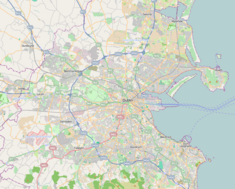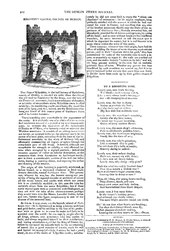Tower house in Dún Laoghaire–Rathdown, Ireland
| Kilgobbin Castle | |
|---|---|
| Native name Caisleán Chill Ghobáin (Irish) | |
| Sesson Castle | |
 18th century sketch of Kilgobbin Castle by Gabriel Beranger 18th century sketch of Kilgobbin Castle by Gabriel Beranger | |
| Type | tower house |
| Location | Kilgobbin Road, Stepaside, Dún Laoghaire–Rathdown, Ireland |
| Coordinates | 53°15′35″N 6°12′47″W / 53.25966°N 6.21311°W / 53.25966; -6.21311 |
| Built | c. 1476 |
| Architectural style(s) | Norman |
  | |
Kilgobbin Castle is a 15th-century tower house in Dublin, Ireland.
Location
Kilgobbin Castle is located to the north of Stepaside and east of Two Rock, guarding the southern approach to Dublin from County Wicklow.
History
Archeological excavations have shown that the site of the tower house was inhabited long before it was built; there is evidence of 11th–12th century metalworking, a 13th-century "plough pebble" and 13th–14th century pottery.
Kilgobbin Castle was built by the Cambro-Norman Walsh family c. 1476, as one of the Pale towers built after King Henry VI, in 1429, awarded a grant of ten pounds to any man who built a castle on the edge of the Pale; it was one of several on the southern edge of The Pale. In 1476 the castle was sacked by the O'Byrnes.
In 1641 the Walshes were dispossessed, with the castle going to Adam Loftus, who then rented it to Mathew Talbot, an officer in the Confederate Irish Army, and the castle was an important site in the Irish Confederate Wars of the 1640s, including a skirmish near the castle in January 1642. After that war it was granted to Dr. John Harding of Trinity College, Dublin. In the 19th century it was owned by the Eustaces, the McDonnells and the judge and scholar Richard Nutley.
It was occupied by several further owners until falling into ruin by the early 19th century. Antiquarian John Lee visited Kilgobbin Castle in 1806–7 and noted it was formerly called Sesson Castle.
Local legend claimed Kilgobbin Castle was haunted by a man in a suit of armor and a woman who carried a bucket of water and rattled coins in her apron.
Building

The castellated fortification is a tall square tower. Only two of the walls are still standing, the north and east walls having collapsed in 1832. The entrance is in the west wall. It is three storeys high with thick granite walls, arrow slits and a vaulted ground floor ceiling. A service tower on the southeast corner contains a spiral staircase and garderobe.
References
- "Final Excavation Report, Landsdown Old Wesley Grounds, Kilgobbin, Co. Dublin" (PDF).
- Gresley, John Morewood (1860). "Anastatic drawing society - Google Books". Retrieved 21 May 2022 – via Books.google.ie.
- ^ "Kilgobbin castle, Co. Dublin | Irish Archaeology". Irisharchaeology.ie. 1 March 2013. Retrieved 21 May 2022.
- Hone, Joseph Maunsell (2002). The New Neighbourhood of Dublin - Joseph Maunsell Hone - Google Books. ISBN 9781899047789. Retrieved 21 May 2022 – via Books.google.ie.
- Fennell, Paul (10 May 2016). "Haunted: A Guide to Paranormal Ireland - Paul Fennell - Google Books". Retrieved 21 May 2022 – via Books.google.ie.
- Fitzachary, John Christopher (1884). "The Bridal of Drimna: And Other Poems - John Christopher Fitzachary - Google Books". Retrieved 21 May 2022 – via Books.google.ie.
- ^ "Ireland In Ruins: Kilgobbin Castle Co Dublin". Irelandinruins.blogspot.com. 7 August 2011. Retrieved 21 May 2022.
- Byrne, Angela (26 October 2018). A Scientific, Antiquarian and Picturesque Tour: John (Fiott) Lee in Ireland ... - Google Books. ISBN 9780429762352. Retrieved 21 May 2022 – via Books.google.ie.
- "Kilgobbin Castle, Stepaside. South County Dublin 1476 > a spooky castle on the border of the Pale | Curious Ireland". Curiousireland.ie. Retrieved 21 May 2022.
This article about a castle in Ireland is a stub. You can help Misplaced Pages by expanding it. |